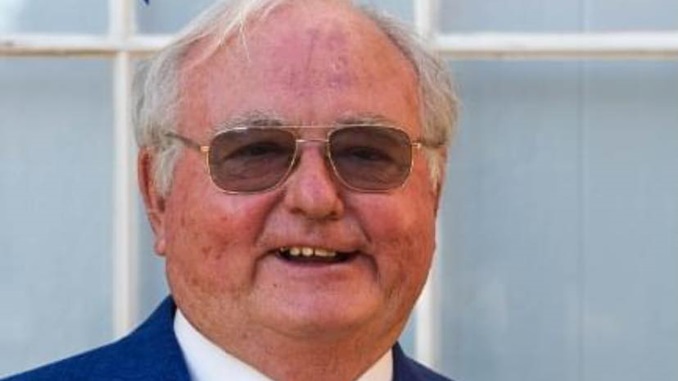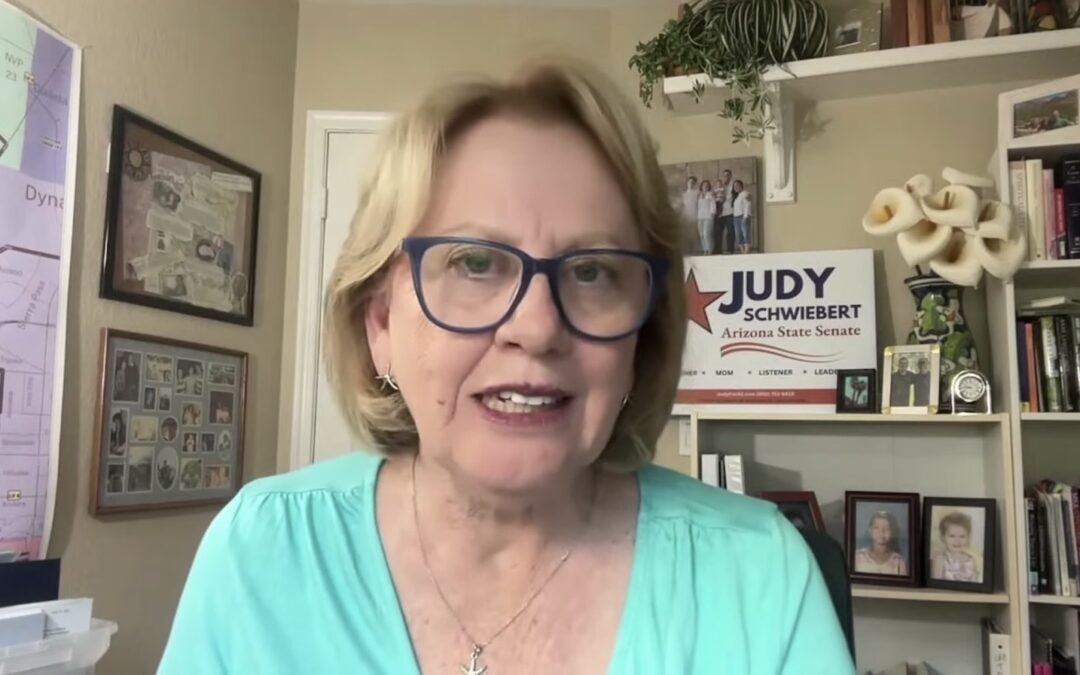
by Staff Reporter | Jul 25, 2024 | Economy, News
By Staff Reporter |
A radical Democrat legislator is seeking a return to a middle-of the-road Arizona district in the upcoming November General Election.
State Representative Keith Seaman is running for reelection in Arizona Legislative District 16. Seaman assumed office in January 2023 after narrowly finishing second in the district in the November 2022 General Election results, beating Republican challenger Rob Hudelson by 644 votes. Seaman now represents the district in the State House of Representative alongside his seatmate, Representative Teresa Martinez, a Republican.
Though the district is more moderate, Seaman has been anything but, as attested by his first term in the state house. On his campaign website, Seaman lists endorsements from left-leaning organizations, such as Arizona Education Association, Save Our Schools Arizona, National Organization for Women Arizona, and Sierra Club Grand Canyon Chapter.
Seaman’s votes in the Arizona Legislature show a pattern of being soft on crime. He voted against HB 2435, which would have “require[d] a person who is convicted of a third or subsequent organized retail theft offense to be sentenced as a category two repetitive offender” (2024). He also voted against SB 1583, which would have mandated that “a level one sex offender who commits specified sexual offenses is required to register on the internet sex offender website if the offender was sentenced for a dangerous crime against children” (2023). Additionally, he voted against SCR 1021, a ballot referral, which would “statutorily require an adult who is convicted of a class 2 felony for any child sex trafficking offense to be sentenced to natural life imprisonment” – should voters approve it in the upcoming November General Election.
The Democrat legislator also made controversial votes related to the border crisis facing his state. He opposed HB 2621, which would have deemed that the trafficking of fentanyl across Arizona’s border is a public health crisis. He also spurned SCR 1042, which “proclaim[ed] the Legislature’s support for the people and government of the state of Texas in its efforts to secure [the U.S.] southern border.”
He also took a stance against policies that would lead to economic prosperity in Arizona. Seaman voted no on SB 1260, which would have “reduced the state’s small business income tax rate to 2.5%” (2023). And he opposed SB 1370, the lemonade stand bill, which would have exempted a minor or a person who has not graduated from high school from the requirement to obtain a TPT license and pay TPT (use tax and local excise taxes) if the person’s business gross proceeds of sales or gross income is less than $10,000 per calendar year.
Seaman has also proven to be an ardent opponent of Arizona’s historic school choice program. Last year, he joined several of his colleagues in the legislature’s Teacher Caucus to castigate the ESA program. He posted, “As a retired educator, I support our public schools and will fight to ensure that they receive the funding they need. Arizona taxpayer dollars should not be used to fund private institutions while public schools struggle with budget cuts and a lack of resources for students.”
On the education front, Seaman voted against HB 2629, which would have “establish[ed] November 7 of each year as Victims of Communism Day and require[d] the State Board of Education to create a list of recommended resources for mandatory instruction on the topic in certain public school courses.” He also registered a vote against HB 2779, which would have “specifie[d] that the State Board of Education, must require, in course of study and competency requirements, that students be taught about the Holocaust and other genocides for at least three school periods, or the equivalent, on at least two separate occasions during any of the 7th-12th grades.”
It wasn’t just what Seaman opposed that made him too radical for the district; it was also what he promoted that flew in the face of a likely majority of his constituents. Seamon cosponsored HB 2610, which would have created a state-owned bank (2023). He cosponsored HB 2068, which would have repealed designating school sports by biological sex (2023). And he cosponsored HB 2653, which would have established that “restaurants and other food service establishments in this state may only serve water and disposable straws to customers on request” (2023).
Arizona Legislative District 16 is one of the most competitive in the state with a 3.6% vote spread between Republicans and Democrats in the last nine statewide elections, according to the Arizona Independent Redistricting Commission. However, in those nine statewide elections, Republicans have emerged victorious in all nine.
Representative Seaman’s daughter, Stacey, is attempting to join him in the legislature next year. She is running for state senate and will go head-to-head against incumbent T.J. Shope for the right to represent Arizona Legislative District 16 constituents for the next two years.
Seaman is again the only Democrat running in the Legislative District 16 primary, as his party again attempts to gain an advantage in the General Election with this single-shot approach. He will face two Republicans who will emerge from a crowded primary later this month. Those Republicans are Martinez, Hudelson, Chris Lopez, and Gabriela Saucedo Mercer.
AZ Free News is your #1 source for Arizona news and politics. You can send us news tips using this link.

by Staff Reporter | Jul 25, 2024 | News
By Staff Reporter |
A major Democrat super political action committee, the PAC for America’s Future, is investing heavily in Arizona this election year. PAC for America’s Future is not only the largest PAC in Arizona; it is a top donor to the Democratic Party.
PAC For America’s Future has focused on Arizona, one of the more contentious of the six key swing states for the election, alongside Wisconsin, Pennsylvania, Michigan, Georgia, and Nevada. According to the Arizona secretary of state’s campaign finance portal, the PAC is the second-largest in the state with over $9.5 million in income and $4.2 million in expenditures, after Arizona for Abortion Access ($12.3 million income, $9.6 million expense). However, PAC for America’s Future has the highest cash balance in the state: over $8.3 million.
These funds are from out-of-state interests, not Arizonans. AZ Free News reviewed all finance reports and found that total funds from Arizonans amounted to slightly less than $13,500 across 122 donations (some of whom were recurring donors). That’s .0014 percent of total donations since last year.
Most of the other funds come from sizable contributions by wealthy out-of-state Democrats. Jonathan Soros, heir to father George Soros’ $25 billion empire, has given $2 million to PAC for America’s Future this year and remains their single-highest donor.
Other top donors from last year to this year include:
- $500,000 from Lynn Schusterman, an Oklahoma billionaire and wife of the late oil and gas founder Charles Schusterman
- $1 million from Wendy and Barry Munger, Californians and children of former Berkshire Hathaway vice chair and late Charles Munger
- $400,000 from Indiana philanthropist Deborah Simon, daughter of billionaire shopping mall magnate Melvin Simon
- $400,000 from Steven Laufer, economist with the Federal Reserve Board
- $300,000 from Debra Ann Efroymson, a New Mexico descendant of the wealthy Efroymson dynasty
- $250,000 from New York property management tycoon Gideon Friedman
- $245,000 from billionaire California philanthropist John Pritzker, son of Hyatt Corporation founder Jay Pritzker
- $200,000 from David Karp, former CEO of major social media platform Tumblr
- $100,000 from a Paul Karp (Paul Haahr), a Google software engineer out of California
- $100,000 from Linda Schlein, the wife to venture capitalist Ted Schlein out of California
- $170,000 from multiple members of the billionaire Pigott family out of Seattle, Washington
- $75,000 from Juan Sebastian Scripps, an angel investor out of Kentucky
- $75,000 from Andrew Beck, a New York-based philanthropist
- $50,000 from Steven Spielberg, the acclaimed Hollywood director
- $50,000 from Kate Capshaw, a Hollywood actress
- $50,000 from Jacqueline Asplundh, the Asplundh Tree Expert Company scion out of Florida
- $50,000 from Brian Rosenthal, the engineering director for Facebook residing in New York
- $50,000 from Lorin Silverman, the New York descendant of business tycoon Marty Silverman
PAC for America’s Future’s affiliates have also brought in millions for the cause. These affiliates serve as holding entities for transferring funds to the PAC.
PAC for America’s Future formerly went by the “Future Now Fund” up until 2021. It’s a repository for funds from major Democratic dark money donors like George Soros and funder to one of the state’s leading dark money nonprofits, Progress Arizona, the outfit led in part by Governor Katie Hobbs’ former press secretary Josselyn Berry. (She rejoined after resigning from the governor’s office due to her posted gun violence threat to “transphobes” last year within hours of the Nashville elementary school shooting.)
Given its most recent name, it should come as no surprise that PAC for America’s Future is listed as “related” on tax returns to two similarly named 501c4 nonprofit entities: Future Now Action and Future Forward USA Action. The two nonprofits also operate a super PAC, Future Forward PAC, which has received nearly $19 million so far this year from Future Forward USA Action ($12 million in 2022).
This network of millions is a critical resource for the Democratic Party during election years.
Jennifer O’Malley Dillon, White House deputy chief of staff and Biden’s 2020 campaign manager, told The New York Times that the Future Forward ecosystem was “critical” in the 2020 presidential election, and would be again this year.
The Biden team directed his 2020 campaign finance director and White House deputy assistant Katie Petrelius to join the Future Forward team.
The Soros family’s Open Societies Foundation gave $15 million to Future Forward USA Action in 2022 and $5.5 million in 2021. The Arabella Advisors dark money network has also given millions to PAC for America’s Future and the two related “Future” nonprofit entities.
Although few of this mega PAC’s funds come from Arizonans, the Arizona Democratic Party, its candidates, and close-knit organizations have benefitted. In this most recent quarterly campaign finance report, as well as the last, the Arizona Democratic Party received nearly $300,000.
In the last campaign finance report, PAC for America’s Future reported spending over $140,000 on Arizona’s Democratic candidates, with all candidates receiving $10,800 boosts each. AZ List PAC also received $27,000.
For the State House, these donations went to candidates Deborah Howard, Stephanie Simacek, Oscar De Los Santos, Brandy Reese, Nicholas Gonzales, Matias Rosales, Mariana Sandoval, Karen Gresham, and Kevin Volk. For the State Senate, these donations went to Christine Marsh, Analise Ortiz, John McLean, and Stacy Seaman.
PAC for America’s Future is technically a “hybrid” committee — or “Carey” committee — meaning it’s capable of making independent expenditures as well as direct contributions to candidates.
A donor’s first $5,000 goes to a contribution account per PAC for America’s Future’s donor site. All funds beyond that $5,000 cap go into a non-federal account. That latter account is for PAC for America’s Future’s 527 committee, a tax-exempt type of committee that allows for unlimited donations to support or defeat political candidates but requires disclosure of all donors and expenses.
PAC for America’s Future’s 527 Committee then funnels the donations in excess of $5,000 — estimated to amount to tens of millions — to PAC for America’s Future’s joint initiative with Future Now Action, “The States Project” (TSP).
TSP took credit for moves undertaken to flip the Arizona legislature blue, dating back to their initial claim of victory in 2018 with four seats flipped for Democrats in the state House; then two new seats in the House and one new seat in the Senate in 2020; and then defense of won seats in 2022.
“Flipping both chambers in Arizona is possible in 2024. In the Senate 1,500 voters changing their minds would have shifted the balance of power in 2022. And in the House, we see a clear path to governing power, as less than 1,000 voters shifting would have ended rightwing control. Investing in the districts where we see the opportunities to shift power now gives us the strongest shot at achieving our goals in the state.” – TSP
Based on the influx of funds through their various PAC for America’s future tributaries, it appears that wealthy out-of-state interests have a vested interest in ensuring Arizona goes from a swing state to a firmly blue stronghold.
AZ Free News is your #1 source for Arizona news and politics. You can send us news tips using this link.

by Staff Reporter | Jul 24, 2024 | Education, News
By Staff Reporter |
State Superintendent of Public Instruction Tom Horne is advising Arizona’s school districts and charter schools to consult legal counsel regarding implementation of the controversial Title IX changes.
The changes to Title IX center on the redefining of the term “sex” to include “gender identity.” In effect, schools would be required to permit access to gendered programs, activities, or spaces on the basis of gender identity rather than biological sex, such as sports teams, locker rooms, and bathrooms. The U.S. Department of Education (ED) released the final Title IX rules outlining this change in April.
In ED’s justification for expanding the concept of “sex” to include “gender identity,” the agency declared that basing exclusion on biological sex amounted to sex discrimination.
“For more than 50 years, Title IX has promised an equal opportunity to learn and thrive in our nation’s schools free from sex discrimination,” said U.S. Secretary of Education Miguel Cardona. “These final regulations build on the legacy of Title IX by clarifying that all our nation’s students can access schools that are safe, welcoming, and respect their rights.”
These new rules take effect on Aug. 1.
In a press release on Monday, Horne announced that he’d advised legal counsel to educational institutions through letters disseminated to all districts and charters. Horne emphasized that, though all schools had the choice to implement the updated Title IX regulations, there were pending legal challenges that may result in students suffering damages.
“This is your choice, but you may wish to delay implementing the new regulations until the legal situation is clarified. If the regulations are implemented and then later overruled by the courts, students may suffer damages in the meantime,” said Horne. “This is not legal advice. The Arizona Attorney General may disagree […] We are a local control state, and it will be up to districts and charters to determine how to proceed in this situation. You need to consult with your lawyer. I am only providing information I think might be useful.”
Indeed, a federal court in Louisiana ruled against the new regulations last month. The judge determined that the new federal rules amounted to federal overreach, calling ED’s rulemaking “arbitrary and capricious,” and signaling concern for the rules’ threat to protected constitutional speech.
Some districts have already opposed the changes.
Dysart Unified School District’s governing board voted to reject the new Title IX rules earlier this month. The district declared that ED’s changes to Title IX were contradictory to the existing, plain language of the rules.
Horne noted in Monday’s press release that the new Title IX rules could “significantly injure public education” by prompting parents to flee the system.
“In the past I’ve been asked by districts, as a policy matter, about their consideration of rules, permitting biological boys who have male genitalia being allowed in girls’ bathrooms, locker rooms, and showers,” said Horne. “My response was that there should be unisex bathrooms available, and if there was no room for them, the faculty bathroom should be used for that purpose. That would preserve the dignity of biological boys who identify as girls. But if they were allowed in girls’ facilities, I thought parents might well remove the girls from the school and send them to another district, Charter School, or private school. So, this rule could significantly injure public education.”
26 states have put forth legal challenges to the Title IX changes, with some awarded injunctions: Alabama, Alaska, Arkansas, Florida, Georgia, Idaho, Indiana, Iowa, Kansas, Kentucky, Louisiana, Mississippi, Missouri, Montana, Nebraska, North Dakota, Ohio, Oklahoma, South Carolina, South Dakota, Tennessee, Texas, Utah, Virginia, West Virginia, and Wyoming.
AZ Free News is your #1 source for Arizona news and politics. You can send us news tips using this link.

by Staff Reporter | Jul 24, 2024 | News
By Staff Reporter |
Come November, Arizona voters may decide whether to establish abortion at any stage of pregnancy as a fundamental right in the state constitution.
The assigned ballot number, Proposition 139, declares that voting in favor of the initiative would create a fundamental right to abortion, thereby limiting the state’s ability to interfere with all abortions — mainly those pregnancies predating the generally accepted standard for viability, around 24 weeks.
However, that doesn’t mean that abortions won’t be covered by the state constitution after viability. The proposition declares that abortions will be permissible after viability should any involved health care professional determine them “necessary” to protect the mother’s life or health.
The proposition would also preemptively ban lawmakers from imposing any criminal sanctions or other punishments on anyone who assists another in obtaining an abortion.
“A ‘yes’ vote shall have the effect of creating a fundamental right to abortion under Arizona’s constitution. The State will not be able to interfere with this fundamental right before fetal viability, unless it has a compelling reason and does so in the least restrictive way possible. Fetal viability means the point in the pregnancy when, in the good-faith judgment of a treating health care professional, the fetus has a significant likelihood of survival outside the uterus. Throughout the pregnancy, both before and after fetal viability, the State will not be able to interfere with the good-faith judgment of a treating health care professional that an abortion is necessary to protect the life or health of the pregnant individual. The State will not be able to penalize any person for aiding or assisting a pregnant individual in exercising the right to an abortion.”
The secretary of state’s office is still reviewing signatures for the initiative.
Earlier this month, the PAC behind the initiative, Arizona For Abortion Access, sued the Arizona Legislative Council for using the term “unborn human being” rather than “unborn fetus” in their official analysis of the proposition distributed to voters in a publicity pamphlet.
An attorney for the PAC told lawmakers during their hearing on the subject that “unborn human being” was a partisan phrase, rather than their preferred term of “fetus.”
Arizona For Abortion Access, the political action committee behind the ballot initiative, has pulled in nearly $23.2 million for their cause.
The PAC’s biggest donors are mainly out-of-state entities: over $13.4 million altogether from The Fairness Project, Planned Parenthood Action Fund, Sixteen Thirty Fund, Advocacy Action Fund, the ACLU Foundation, Open Society Action Fund, Think Big America, The Green Advocacy, Movement Voter PAC and Project, Our Children Our Future, Clean and Prosperous America, and Moms Fed Up.
Several in-state entities rich with out-of-state cash flow put about $5.8 million toward the initiative: Arizonans Fed Up With Failing Health, ACLU of Arizona, Reproductive Freedom for All Arizona, Healthcare Rising Arizona, and the UFCW Local 99 PAC.
A number of wealthy, out-of-state billionaires have donated funds:
- Phoebe Gates, daughter of Bill Gates and Stanford University student, $750,000;
- Liz Simons, daughter of hedge fund billionaire James Simons, $250,000;
- Gaye Pigott, a Washington descendant of one of America’s richest families, the Pigott family, $75,000;
- Eric Laufer, a New York engineer, $65,000;
- Giovanna Randall, president and head designer of New York luxury bridal company Honor NYC $65,000;
- Barbara Simons, a retiree of San Francisco, California $51,000;
- Barton Faber, former Canto executive, a California-based software company (reported as living in Hawaii, but formerly from Arizona), $50,000;
- Ning Mosberger-Tang, a Colorado photographer, gave $50,000;
- Steven Spielberg, famed Hollywood director, and his Hollywood actress wife, Kate Capshaw, gave $100,000;
- Sheli Rosenberg, a retired Illinois executive of Equity Group Investments, gave $50,000;
- Gregory Serrurier, retired California cofounder of Redwood Grove Capital, $50,000;
- Eric Uhrhane, a Californian software engineer and angel investor, gave $50,000;
- Laura H. Lauder, a California philanthropist, gave $25,000;
- Georgia Taylor Michelson, Californian and wife to Zimmer Biomet board member Michael Michelson, gave $25,000;
- Marcia Grand, a California donor, gave $25,000;
- Sal Al-Rashid, a New York investor, gave $25,000;
- Elizabeth Brown, a California farmer, gave $25,000;
- Robin Donohoe, a Georgia venture capitalist, gave $25,000
Several wealthy in-state donors also gave. Among them were Juanita Fitzer Francis, who gave $200,000 — a former nurse with University of Arizona College of Medicine and Phoenix Children’s Hospital, and board member of the Arizona State University Foundation and University of Illinois Foundation. Francis also presides over the Francis Family Foundation.
There was also David and Louise Reese, who gave about $200,000 together. They operate the David E. Reese Family Foundation, a private grantmaking foundation in Paradise Valley. David formerly ran banking institutions across Arizona, Ohio, and New York.
And then there’s Sedona’s Donalyn Mikles, who gave $100,000. Mikles has been a top donor for the Democratic Party and Gov. Katie Hobbs in recent years. Mikles has served as a director of the Kling Family Foundation, a private philanthropic California nonprofit.
Donald Levin, a DRL Enterprises executive in Phoenix, gave $50,000. Paul Lipton, a Tucson hydroponics supply company founder, gave $25,000. Likewise, Robert Bertrand, a Paradise Valley retired executive of Concord Servicing, gave $25,000.
They’ve spent nearly $13.5 million so far, around $11 million on signature gathering. The second-largest expenditure was on advertising, generally, amounting to over $500,000, and polling came at a cost of over $100,000.
Staff salaries for other organizations also topped the list: staffing for Healthcare Rising, Reproductive Freedom for All Arizona, The Fairness Project, and the ACLU altogether amounted to over $400,000.
Their cash balance sits at just over $9.7 million.
AZ Free News is your #1 source for Arizona news and politics. You can send us news tips using this link.

by Staff Reporter | Jul 22, 2024 | Education, News
By Staff Reporter |
Another one of Arizona’s middle-of-the-road legislative districts may be represented by a liberal after November’s General Election if enough Democrats and left-leaning independents have their say.
Judy Schwiebert, a Democrat, is running for the Arizona State Senate in Legislative District 2. Schwiebert currently serves as a State Representative for the district. She announced for the seat in June 2023, saying that “we need people who will work together to focus on the toughest challenges facing Arizonans including our teacher, affordable housing, and water shortage crises.”
Schwiebert posted more than 1,600 signatures at the Arizona Secretary of State’s Office earlier this spring to qualify for the ballot.
The Democrat legislator has been endorsed by several left-leaning organizations, including National Organization for Women Arizona PAC, Arizona Education Association, Moms Demand Action, Save Our Schools Arizona, Arizona List, Jane Fonda Climate PAC, the Grand Canyon Chapter of the Sierra Club, Emily’s List, Moms Fed Up, and Human Rights Campaign PAC.
If voters were to select Schwiebert over the Republican favorite in the district’s primary, Shawnna Bolick, they would be sacrificing one of the state’s strongest school choice proponents for one of the top opponents of educational opportunities and freedom for students and families. In a recent interview with a local outlet, Schwiebert set her sights on the Empowerment Scholarship Account (ESA) program, which has given tens of thousands of Arizona families the opportunity to choose the education that best suits their children, saying, “What we cannot afford is to create an entirely separate private school system – funded by taxpayer money – that siphons almost a billion dollars a year out of the state budget. That’s what the universal ESA voucher program is doing. It is creating huge deficits. It is preventing us from investing in all kinds of things that Arizonans urgently need.”
In June 2022, Representative Schwiebert voted against the bill that expanded the ESA program in the state (HB 2853), which was the first of its kind in the country.
Schwiebert’s endorsements from Arizona Education Association and Save Our Schools Arizona also speak volumes about what she would continue to do in the state senate to undermine school choice opportunities for her constituents. In its 2023 Legislative Policy Priorities, Save Our Schools Arizona wrote that “Diverting public funds away from public schools toward private schools through ESAs and STOs only exacerbates the crisis – especially with universal ESA vouchers directing state tax dollars overwhelmingly to families who never sent their children to public schools in the first place. This negatively affects Arizona students and families, leaving the next generation unprepared for success and risking our state’s future.”
On her “X” account, Schwiebert has posted her participation with Save Our Schools Arizona at different events.
The Arizona Education Association is also an ardent opponent of the state’s many educational freedom opportunities. After Democrat Governor Katie Hobbs signed the state’s budget in 2023, which she negotiated with Republican legislative leadership, the Association wrote, “It’s extremely frustrating that this budget does not address the growth of the state’s out-of-control voucher program. The extremist majority in our state legislature has ignored the will of Arizona voters and pushed through policies that bankroll private schools for the wealthy at the cost of the public schools attended by 90% of Arizona kids…This unchecked spending is completely irresponsible and is on track to bankrupt our state. The fight to repeal vouchers during next year’s legislative session starts today.”
Earlier this year, Schwiebert bemoaned the resistance of Arizona Republican legislators in the House majority “to even consider sensible legislation to raise educator pay…”
However, during the 2023 Arizona Legislative Session, Schwiebert voted against HB 2800 in committee, which would have “mandate[d] each school district and charter school increase the base salary of all eligible teachers” – according to the overview provided by the state House of Representatives. That bill, which was sponsored by Republican State Representative Matt Gress, received a green light from the House Appropriations Committee, but failed to make it out of the full chamber for the Senate’s consideration.
Schwiebert explained her vote at the time, saying, “The bottom line for me is well, this bill is really, I think, well-intentioned, and it’s good that, I’m glad to hear that Mr. Gress is acknowledging that teachers deserve higher pay, they absolutely do. But unfortunately, there are some serious flaws in this bill that I’m concerned could leave public schools in a worse financial position than they are in now.”
Representatives from both the Arizona Education Association and Save Our Schools Arizona registered opposition to the legislation on the Arizona Legislature’s Request to Speak system.
Arizona Legislative District 2 is one of the most competitive in the state, with a 3.8% vote spread in the past nine statewide elections. It is very winnable for Republicans, however, as the party has emerged victorious in six out of those nine elections. The district covers a large portion of northcentral Phoenix.
Schwiebert is running unopposed in the July primary election for Democrats. She will face off against the winner of the district’s Republican primary contest for state senator, which features incumbent, Shawnna Bolick, and Josh Barnett.
Bolick told AZ Free News that her “general election opponent was voted in shortly after she helped collect signatures for a ballot initiative that would have levied a billion dollar tax on small businesses not only hurting these business owners, but our state’s economy.” She added, “[Schwiebert] cares more about protecting special interests than voting for common sense education policies that gives every kid a chance to thrive in the school of their choice.”
AZ Free News is your #1 source for Arizona news and politics. You can send us news tips using this link.





